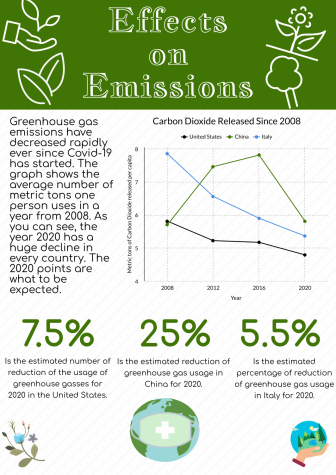Environmental side effects
As the COVID-19 pandemic continues to unfold, many are starting to see the environmental impact it’s having on the world.
In the past few months, the world has been turned upside down. There have been over 3.2 million COVID-19 cases worldwide and on April 27, the U.S. surpassed 1 million cases and became the country with the most people infected. Towns all over the world are deserted as governments have implemented “stay at home” orders. As a result, the world of manufacturing has been halted and factory emissions are visibly lower. With less travel and more people staying in their homes, people started taking note of environmental changes.
All over social media, pictures have been shared of the sky in China and India where air pollution has decreased and Italy’s canals changing color due to the lack of use. With less travel, global emissions have decreased greatly since transportation contributes to 23% of greenhouse emissions. However, many doubt the change will last.
“There are large quantities of fuel sources and raw materials that have stockpiled due to COVID-19,” said University of Iowa Professor R. William Field, a member of the Occupational and Environmental Health department. “Once the workforce is able to return to work, emissions will increase greatly due to pent up demand.”
This has already proven to be true in China. During the first few months of the outbreak, the country reduced its emissions by 25%, but as they rebuild their economy, the numbers are climbing. People are still hopeful that as a country the United States will be able to make a change once this is done.
“I like to think we will see positive changes, but part of me thinks people will spring back into the ‘old ways,’” said science teacher Byron Butler.
However, many are doubtful because of a similar economic situation the nation faced in 2008. The recession that year led to a very similar pattern.
“During the financial crash of 2008/2009, there was a substantial reduction in emissions,” Field said. “However, emission increased back to record levels not too many years after the financial crisis.”
According to the BBC, 2020 may still see a drop in global emissions of 0.3%, which is less pronounced than the drop during the crash of 2008. If we go back to emitting greenhouses gases at our previous rate after quarantine, it is likely that emissions will increase back to where they were before, just like after the recession.
“Some people may perceive that it is relatively ‘easy’ to reduce greenhouse emissions and it can be done in the future ‘if needed,’” Field said.

While some people will perceive that having high emissions is easy to fix, science teacher Maureen Head hopes it will change attitudes.
“Perhaps it will be motivating to see that if we take collective action we really can make positive changes to our world,” Head said. “But the cynic in me thinks that may be wishful thinking.”
While many are concerned about how gas emissions will be affected by the pandemic, many countries are taking on a more relaxed attitude towards environmental policies during COVID-19. This new attitude may cause immediate trouble.
With the number of people doing online orders for food and groceries, more one-use plastics are being disposed of. Some businesses, such as Starbucks, aren’t accepting reusable cups during this time either. Not only are companies relaxing environmental rules, the government is doing the same.
“The pandemic is being used as a ‘smokescreen’ to relax environmental laws such as the Clean Water Act, fuel mileage standards, toxicant releases, and for pesticide use expansion, etc,” Field said.
Field was a member of the Environmental Protection Agency, or EPA, for eight years and shares that “the degradation of environmental laws has been going on the last three years,” but feels that it is being brought to another level.
“The abandonment of environmental laws and policies has accelerated since COVID-19,” Field said.
All of these factors contribute to an uncertain outcome of events. The lowering amounts of travel and power consumption point to lowering emissions while environmental laws are being relaxed will contribute to a rebound in greenhouse gas levels after the lockdowns.
After the pandemic and economic low is over, the world will face a choice. One option is that emissions will come soaring back up to where they were before the pandemic if countries lean into the old and dirty energy sources such as the well-known cheap oil to rebuild economies. On the other hand, U.S citizens have the option to rebuild the economy using renewable energy sources, electrical vehicles, and investments in low carbon infrastructure, and use the stunted emissions to their advantage.
No matter what happens, this pandemic and its effects will go down in history and will be something taught about for years to come.
“It’s a relevant issue for all of us who have lived through this event,” Head said.
Your donation will support the student journalists of West High School. Your contribution will allow us to purchase Scholarship Yearbooks, newsroom equipment and cover our annual website hosting costs.

(they/them) Katherine Shoppa is a senior in high school and this is their third year on staff. They are the Co-Editor-in-Chief of the...


